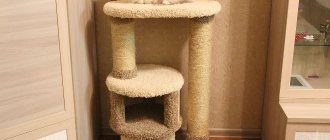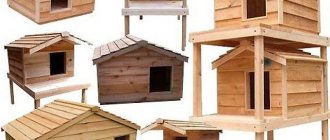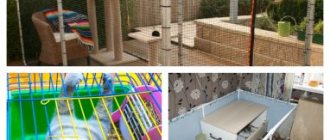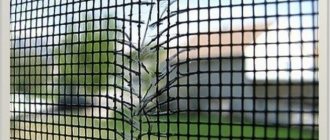It is often not possible to provide cats with a warm home or basement that provides even a little protection from the cold. If a cat lives at your dacha or in a private house, and you don’t go there every day in winter, you can buy a winter house for your cat outside. There are many models of houses in which the animal will wait for the breadwinner to come home from work. A wonderful, warm hut will help the animal spend rainy days, cool evenings, and cold nights.
Wooden winter house for a cat – photo
Choosing a house
When choosing a shelter for a domestic cat, most owners consider primarily aesthetic qualities, partially ignoring the needs of the pet. Outdoor cat huts are exposed to changing weather conditions and must be made of durable materials that are resistant to abrasion and scratches.
Housing may be equipped with stairs. Manufacturers offer options from:
The appearance of the houses is varied, allowing you to find a model that is suitable for your pet and pleasing to the eye. For example, some options from the varied offer:
- royal castle with towers,
- mouse,
- tent,
- wooden cottage.
Walls
A good booth is made of pine wood with polystyrene foam insulation. The design includes:
- thick boards (18-20 mm thick),
- polystyrene foam 2-3 cm thick.
Thick, warm materials of the walls and floors will provide your four-legged friend with a comfortable, warm den. Walls need to be protected from moisture, direct contact with the scorching sun and wind using impregnation.
Roof, floor
Pay attention to the roof. The roof is covered with:
- bitumen,
- sheet iron,
- other waterproof material.
An interesting option is two-story houses, the second floor does not lie directly on the ground, the floor of the upper floor is warmer.
Soft bed
For sleeping, cats most often choose soft pillows, the backs of sofas and other places that are comfortable from their point of view. But it is in these places that the largest amount of wool is always collected. You can solve the problem with the help of a small soft bed.
It is better to use natural fabric that will not electrify - linen, cotton, wool. The filler can be batting or padding polyester.
You can easily make such a bed in one evening
You will need to cut out a pillow-lounger, sides (we will later fill them with soft filling) and handles for carrying. Make a small depression in one of the sides - it will be more convenient for the cat to enter and exit through it.
To give our design its shape, attach a sheet of cardboard to the bottom.
A hanging bed can be attached to a radiator - after all, cats are constantly trying to find a warmer place. To make the frame of such a product you will need very strong wire.
The cover is sewn from two pieces of fabric. Wrap the hanging parts of the frame with fabric or twine. If the fabric bottom of the bed sag a little, it’s okay - if the shape of its bed resembles a hammock, the animal will only be happy about it.
You can even create a cozy place for your pet from an old stool by upholstering its sides first with chipboard or plywood, and then with thick fabric or carpet. Prepare a shelf in it that will serve as a sleeping place.
The author of this video assembled a whole play complex from furniture scraps for a tailed member of his family. You can see all the stages of creating a cat house with your own hands in the video:
How to make a winter house with your own hands?
Building an outdoor house for a cat is not difficult and does not require large financial expenditures. The simplest option is made from an ordinary cardboard box.
Materials
The following materials will be required:
- a large cardboard box or an old bedside table left over when replacing furniture;
- a little tape,
- Styrofoam,
- film or tablecloth to protect the structure from moisture.
It is advisable to glue the parts with tape - some suggest using glue. Glue is a controversial solution; adhesive compositions often emit an unpleasant odor that persists for a long time. Cats have a keen sense of smell and may end up living in a smelly house. Good quality tape works great in this situation.
Dwelling size
When choosing the size of the box, you must take into account the size and number of animals:
- the dwelling of one animal should not be too large, because the animal will not be able to warm a large container with its own heat;
- the box cannot be too small, the animal must be able to freely change its body position;
- if this is housing for several cats, the size of the house should be adjusted to their number - in cold weather, some cats sit in one place, warming each other with warmth, even if they are cramped.
The dimensions of the house are approximately 50 x 40 x 30 cm (height x width x length). Larger boxes store worse, accumulate heat, and hold more cold air for heating. In a small space, the cat curls up into a ball and sleeps comfortably.
How to make a house - master class, photo
- After choosing a cardboard box (you can always make one too large), seal the bottom and top with wide tape. It is advisable to seal the bottom of the booth with cardboard.
- Cut out the inlet hole. When cutting out the inlet hole, you should not overdo it with the size. It is important that snow does not get inside so that the box does not cool too quickly. The recommended size of the entrance hole is 14 by 14 cm. The entrance is protected with adhesive tape, as are all edges of the cardboard.
- The prepared box must be insulated with polystyrene. Polystyrene and polystyrene foam are sold in hardware stores. 4 panels are enough.
- We glue each side separately with a piece of polystyrene foam board. To secure the polystyrene we use wide tape. It is important that the foam is well fixed and does not move. Pay special attention to the entrance, the foam must be installed so that the cardboard is not visible, to prevent water from getting under the foam. Otherwise, the walls of the house will quickly get wet, and the structure will not last long.
- When you have successfully sealed the cardboard walls with polystyrene foam, the entire structure must be wrapped in waterproof material (for example, oilcloth, thick film). The thicker the material protecting the walls, the less likely it is to break. The cat may accidentally tear the film with its claws, so you need to make at least a double layer of film in places where the animal can sharpen its claws.
- Canopy, door. It’s a good idea to make a small canopy over the entrance from a piece of plexiglass or rubber to protect against water getting inside. At the entrance you can hang a piece of thick fabric, felt, a piece of rubber, thick, transparent film, linoleum, protecting your home from rain, snow, and wind. The door can be glued with wide tape.
- An important element that creates warmth and comfort is bedding. Wool and fleece are excellent for bedding - fabric that does not absorb moisture from the environment. Wool has the disadvantage that if it gets wet, it will take a long time to dry. It is preferable to use fleece. Fleece fabric is specially designed for winter weather conditions. The litter must sometimes be removed, dried, and replaced if necessary. Even a warm house can get moisture, the animal brings water, snow on its paws, and fur.
- The last element is fixing the home. You need to use a heavy base, for example, half a Euro pallet. A cat's house made of polystyrene foam is not very stable, it is important to attach and weigh down the base. Thanks to a piece of pallet, the house will be more stable, more resistant to winds, and separated from the ground, making the floor warmer.
- The last stage is finding a suitable location for the home. It is worth putting a sign on the home so that the janitor or utility workers do not throw the box in the trash. If you live in an area that is strongly anti-cat, you might want to add the information that cats are the natural enemies of rats and carry a wide range of diseases.
Photo gallery - making a cat house from scrap materials.
Photo 1. House on a pallet.
Photo 2. A small canopy will conveniently protect the entrance from snow and rain getting inside.
Photo 3. The opening must be precisely matched to the size of the animal; too wide an opening will lead to heat loss.
Insulation with foam tiles
It is convenient to insulate a cardboard house with polystyrene boards. They are fastened with wide adhesive tape; it is very important to fix the parts well so that the structure does not “shake.” It is also important to design the entrance well: polystyrene foam should cover the cardboard completely (so that water does not get on it). The visor above it can be made of plexiglass or rubber.
The entire structure, as in the first option, must be tightly covered with a thick film or a piece of waterproof tablecloth. The seams must be taped in the same way.
Why do you need an outdoor cat house?
Perhaps this is the first logical question that comes to mind. And really, why is it so important to do it? After all, cats can survive well in different conditions and the cold is not a hindrance for them. But, in fact, there are many reasons that indicate that such houses for cats are simply necessary, especially in winter. Why can you say this? Here are 5 reasons that will help you decide to build a house for your cat outside:
- There is such a moment that a cat that has strayed, or was simply found on the street, simply does not want to live indoors. Some breeds simply cannot tolerate being confined.
- There is a contingent of people called cat lovers who love these animals so much that they cannot limit themselves to one or two pets. It is clear that keeping more than three cats in the house is quite problematic. And there are a lot of reasons for this that are not even worth talking about. Therefore, an outdoor house for a cat will come in handy.
- The third situation is that the owners may dote on their pet. They would live in the house with him all their lives, but there is one problem - some of the family members are allergic to wool. Then the owners are simply forced to do something in order to remove the source of unpleasant sensations. It is not necessary to give the cat to one of your friends. It is enough to make a house for her on the street.
- A winter house is needed for those owners who are constantly on the move. Such a house will serve as a staging area for the cat. You don’t need to think about where to take your pet, take it with you or leave it, how will it live without care. All these questions immediately disappear.
- Whatever one may say, cats will run around in the yard. And if there is a warm house, their time there will be even more comfortable. After all, every organism needs a roof over its head.
All this tells us that a cat house is an integral part of a home with this pet. This will make life easier for both you and your cat.
Housing built into furniture
You can set up a bedroom for a cat in one of the compartments of a bedside table, closet or chest of drawers. After all, even the most sociable animal needs a place for periodic solitude in which it will feel safe.
After all, even if a pet loves to lie on the sofa, when it sees a stranger, it will most likely look for a secluded place.
To create a house in your nightstand, just make a small hole in it.
It’s definitely not worth allocating space for a house in the hallway. It is better to arrange it in one of the distant rooms, preferably in the one in which the cat is most often. If you are a breeder and your animal is not sterilized, you can also set up a maternity hospital for your cat using ordinary furniture.
To do this, you just need to make a hole in the side wall of the bedside table or closet and build a soft bed from a small children's mattress or an old blanket. If your cat likes to take a nap on an elevated surface, set up a spot for her on one of the bookshelves.
To make it convenient for her to climb up there, place a small ladder nearby, covered with hemp or jute twine.
Even an old chest of drawers can be turned into a cat play set. To do this, you just need to remove the drawers, cover the free space with soft fabric and hang curtains so that the cat can rest quietly in privacy.
A home for two cats should consist of a couple of rooms or have two floors so that each of the pets has their own place.
Options for winter houses for cats
First of all, you can consider the features of designs that are intended for individual use of a domestic cat. Let's start with the fact that it is important to analyze how often the cat is in the yard. Is she there all the time or does she prefer to be at home? If your pet rarely goes outside, especially in winter, you don’t have to focus on building a large and expensive structure. You can get by with a small structure with foam rubber for insulation. There is only one caveat - you will need to raise it a little above the ground. As for the exterior finishing, it can be made of moisture-resistant fabric.
If there is already a booth in the yard, but it is not prepared for winter, then it will have to be insulated. To prevent drafts in the cat house, it is recommended to cover the opening (hole) with an overlapping cloth. There is another important nuance that concerns the design. The point is that cats will do their business inside. Even without this, you will have to clean the inside from time to time. But it is not possible to do this through a small hole. In this case, use the following tricks:
- one of the walls is created to open like a simple door;
- the bottom and walls of the structure are not nailed tightly, but sit on hinges so that it is possible to open and close the structure at the right time;
- the last option is a removable roof.
Thanks to such tricks, you can simplify the process of cleaning and airing your cat's house.
Again, if we talk about the construction of such a temporary booth, any material that is at hand can be chosen. Some make cat houses from cardboard, insulating them with foam rubber, others use plastic, wood, old boxes of something, etc. Some examples of such boxes can be seen in these photos.
As for large structures, comfortable and convenient, which will become a real refuge for a cat, here you can already try to make a reliable structure that will serve for a long time and faithfully. In this case, you will have to try, make efforts and allocate time to create the booth. Typically, such products are made of wood and resemble doghouses. The photo shows an example of such a design.
Self-production
When thinking about how to make a warm cat house for the winter yourself, the first step is to take care of creating a general concept and project. Despite its apparent simplicity, it is impossible to do without preliminary design. At the same time, it can always happen that the cats’ family will be replenished: small kittens will appear, or another stray cat will decide to move into the house. So, it is always better to plan, as they say, “with a reserve.”
Important! Try installing a scratching post next to the cat booth. It could be just a log or a piece of wood.
Meanwhile, more details about scratching posts, although for home use inside an apartment, can be found in this article.
What materials to choose
Of course, the layout, as well as the length and width, are important parameters that you should think about carefully. But after you do this, you can move on to choosing the materials from which the outdoor cat box will be made. And if everything is more or less clear with the floor, walls and finishing (it is best to buy a board or lining), then as for the other structural elements of a small building, they also have their own characteristics. So, it is best to use polystyrene foam or thinner but dense extruded polystyrene foam as insulation. This will keep your cat warm in winter even in severe cold. The frame can be made slatted, and standard solutions such as roofing felt, metal or soft (bitumen) tiles can be used as roofing material. Ondulin is also suitable.
Know! The advantage is that you can use leftover materials or substandard products: this will not particularly affect the final quality.
In addition, you will need consumables and fasteners. Depending on the situation, these could be nails, screws, and so on. Don’t forget about the tools (hammer, screwdriver, hacksaw, pliers, etc.).
Construction stages
So, here is a brief step-by-step instruction for creating and assembling a house for a cat outdoors in winter:
- First of all, you will need to make a frame from slats. Metal mounting angles can be used for connection.
- Fill it inside with insulation, for example, foam boards, which will first need to be cut to size.
- Cover the interior with plywood, OSB sheets or other analogues.
- If you consider it necessary, divide the interior spaces into vertical or horizontal compartments-rooms.
- If you have a pallet, wooden beams or other similar elements on hand, you can make a kind of sled or platform out of them, since a warm cat box should be located at some distance from the ground or sidewalk.
Important! Wooden, and even more so plastic floors and ceilings also need to be reliably insulated.
As an additional option, you can use a special varnish that will protect the wood from rotting and fungus. It has no pronounced odor and is completely safe for animals. In addition, you can make a heated box for your cat. The most acceptable option is infrared insulation. On the other hand, this will complicate the work somewhat and will require wiring. In addition, the total cost will also increase.
By the way, as an alternative, you can do it easier. Take an old nightstand, drawer or something similar: this will serve as a base and you won't have to make a frame. All that remains is to saw through the entrance, cover it with insulation, make a roof and other finishing touches, depending on the situation. The insulation, however, should be protected from moisture. See photos of real examples in the gallery at the bottom of the article.
Another interesting type of shelter that can be made quickly and in a hurry is any large plastic container, including packaging. The main thing is that gasoline and other types of fuel have not been stored in it before. Cut a hole in it and fill it with hay, sawdust or other insulation.
Heated “shelter” above the heating main
Types of ready-made houses for cats
Cats, unlike dogs, have a very independent character. This means that not all of them will be happy to exchange freedom for a limited confined space. Although, if you think about it, a house on the street also has its positive sides. After all, some people never manage to train their wayward cat to use the litter box. The good news is that nowadays many companies are developing their own line of houses for pets that can be placed outdoors. During production, many factors can be taken into account: the size of the cat, the number of pets that will live inside, the climate that prevails in the region and the requests of owners who want to have a special decorative finish.
Photo with dimensions
No matter how much we talk about the design of a cat house, the best way to understand the dimensions is by drawings with dimensions. If you look at them carefully, you will notice a solid run-up. This is understandable - there are large and small cats, and accordingly the size of the cat's house will be larger/smaller. You can adjust them yourself depending on the size of your pets or the available space.
Photos of cat houses with dimensions
Three options for cat corners with sizes
The height of the presented structures is quite large - 180 cm and above, but you can reduce it by removing floors that you think are unnecessary. All these dimensions can be taken as a basis to develop your own layout and put down approximate dimensions. Having the drawing in hand, you can begin purchasing materials and manufacturing.
And the most important thing
Namely: before you take up the tool, take a closer look at the cat. Where she goes, why she goes, what she does where, what she likes and what she doesn’t. Affectionate and firm characters are quite compatible in one creature. For example, Pantyukha, who lives with the author of the article, completely fell in love with a flat avocado box under the kitchen stool. The battery is right behind the back. He jumps from the stool onto the table, and from there onto the windowsill. Either from the remnants of the smell of fruit he is intoxicated, or from the wood of the box itself, but he has grown firmly into his rookery and greets with hysteria any attempts to move him from his beloved slum to a more decent property. And if you give away another new building to your acquaintances, they, you know, Felis Katus, immediately settle in and are beside themselves with delight. That's it.
What can be built
To a large extent, the type of design you choose depends on your specific circumstances, as well as the budget you have. Sometimes something simple and quick to construct will do (a box insulated with foam plastic or foam rubber, etc.), but in other cases you will have to take care of more complex and spacious options.
On a note! Some especially caring owners even install additional heating and install a special thermometer to control the temperature.
But even the construction of a light temporary structure must take into account 2 important conditions:
- It should be raised above the ground. For this you can use bricks, an old pallet and so on.
- It is necessary to ensure waterproofing of the outer layer, no matter what it is made of: moisture from rain, snow and other precipitation should not penetrate inside.
Capital structure
If you need a spacious and solid box for a cat on the street, then it is advisable to make it using internal partitions. They can divide the “room” either into separate compartments or into 2-3 unique “floors”. On the one hand, this will somewhat improve the thermal properties of the cat’s house, and on the other, it will make the animals’ stay inside more comfortable. So, the upper level can play the role of a kind of soft bed. It is desirable, however, that there be only one entrance.
Advice! An important condition is to ensure the possibility of periodic cleaning from the inside. This can be done using an opening roof, removable or hinged wall.
Useful tips and ideas
A house designed for not one, but two inhabitants should be either two-room or two-story. By the way, a building with internal partitions is much warmer than a one-room option.
Be prepared for the fact that the house needs to be cleaned from time to time. To simplify the process, you can open one of the walls like a door. Another option is a removable roof or a folding roof equipped with hinges.
The door of such a home should conveniently open from the inside and slam shut when the owner goes for a walk.
A cat in any circumstances, and especially when it finds itself in nature, begins to hunt. It is more convenient to observe the prey from a height, so a convenient observation post can be provided on the roof.
Don't try to make your cat's home too bright. Your pet will like his home more if it looks natural - just coat the boards with varnish and complete the exterior decoration.
The topic is actively discussed on the Internet, it also has opponents, but most of the participants in the discussion agree: if it is not yet possible to resolve the issue of placing all ownerless animals in nurseries, we need to help at least in this way - by building housing for cats and dogs. After all, they are our brothers. Smaller ones.











